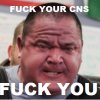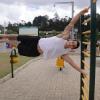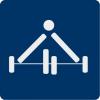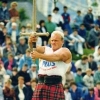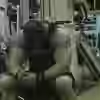Histórico de Reputação
-
 zeppilianus recebeu reputação de lucianob em Diferença De Fazer Exercício Com Peso Livre E MáquinaMeu amigo faz smartfit e ele disse que tem sim peso livre....a unidade dele é,se nao me engano, na clelia...e pra vc que faz na faria lima....vai pra unidade de pinheiros,lá tem peso livre tmbm!
zeppilianus recebeu reputação de lucianob em Diferença De Fazer Exercício Com Peso Livre E MáquinaMeu amigo faz smartfit e ele disse que tem sim peso livre....a unidade dele é,se nao me engano, na clelia...e pra vc que faz na faria lima....vai pra unidade de pinheiros,lá tem peso livre tmbm!
É cara,academia aqui em sao paulo é uma merda,tem aquelas de merda que mal tem ar pra respirar,que mesmo assim sao caras (nao menos que 150 conto) e aquelas estilos bodytech,que é 500 conto e o instrutor nao deixa fazer terra pq é "perigoso"....
Depois de procurar demais aqui na regiao achei a academia da Medicina Usp,na oscar freire....110 por mes é eh bem boa,recomendo pelo CxB
-
 zeppilianus recebeu reputação de FELLIPE ASSIS em Military Press: Discussão, Variações, Platôs, Etc.BTNPP = Behind the neck push press... Seria um push press por trás da cabeça...tira a barra do suporte,poe exatamente como num agacho high bar,e levanta a barra,com o máximo de leg drive possivel...
zeppilianus recebeu reputação de FELLIPE ASSIS em Military Press: Discussão, Variações, Platôs, Etc.BTNPP = Behind the neck push press... Seria um push press por trás da cabeça...tira a barra do suporte,poe exatamente como num agacho high bar,e levanta a barra,com o máximo de leg drive possivel...
https://www.youtube.com/watch?v=vcr9KiBrEHg
Além desse,tem o Klokov Press,que seria um Press com Snatch Grip (pegada muito larga,por trás da cabeca)
https://www.youtube.com/watch?v=BXhPf1Q_XWQ
-
 zeppilianus recebeu reputação de Marcos Alexandre em Military Press: Discussão, Variações, Platôs, Etc.BTNPP = Behind the neck push press... Seria um push press por trás da cabeça...tira a barra do suporte,poe exatamente como num agacho high bar,e levanta a barra,com o máximo de leg drive possivel...
zeppilianus recebeu reputação de Marcos Alexandre em Military Press: Discussão, Variações, Platôs, Etc.BTNPP = Behind the neck push press... Seria um push press por trás da cabeça...tira a barra do suporte,poe exatamente como num agacho high bar,e levanta a barra,com o máximo de leg drive possivel...
https://www.youtube.com/watch?v=vcr9KiBrEHg
Além desse,tem o Klokov Press,que seria um Press com Snatch Grip (pegada muito larga,por trás da cabeca)
https://www.youtube.com/watch?v=BXhPf1Q_XWQ
-
 zeppilianus recebeu reputação de Willian Oliveira em Treinos Upper/lower Push/pullEles tem uma melhor divisão das partes treinadas. Vc treina 2x por semana cada parte do corpo,sendo assim mais proporcional do que treinos ABCDE, por exemplo,que treinam 3X triceps (no treino de peito,no treino de ombro e no treino de braco) e 1x as pernas (apenas no treino de perna). Alem de que uma maior frequencia é bem vista tanto no quesito hipertrofia ,especialmente para naturais,tanto no quesito força/progressão de cargas.
zeppilianus recebeu reputação de Willian Oliveira em Treinos Upper/lower Push/pullEles tem uma melhor divisão das partes treinadas. Vc treina 2x por semana cada parte do corpo,sendo assim mais proporcional do que treinos ABCDE, por exemplo,que treinam 3X triceps (no treino de peito,no treino de ombro e no treino de braco) e 1x as pernas (apenas no treino de perna). Alem de que uma maior frequencia é bem vista tanto no quesito hipertrofia ,especialmente para naturais,tanto no quesito força/progressão de cargas.
Outra razão boa é a recuperação muscular...ao dividir push/pull e upper/lower,vc não irá trabalhar um músculo intensamente 2 dias seguidos,pois a mecânica dos exercícios de um dia se difere dos exercícios do outro dia,melhorando a recuperação muscular e propiciando um melhor treino.
Low/High é basicamente fazer baixas reps em um dia e altas reps em outro dia. Isso ativaria mais fibras musculares,propiciando melhor resultado na hipertrofia,pois ativaria a hipertrofia miofibrilar e a sarcoplasmáticas.
Abs
-
 zeppilianus recebeu reputação de cclm em Dan Green : Whestside Não É A Melhor Escolha Para RawSaiu um artigo essa semana do Dan Green,que quebrou recentemente o recorde total para a categoria 220lbs, falando por que Wsb nao é bom para atletas raw. Lembrando que ele treinou durante anos nesse sistema,chegando à essa conclusão.
zeppilianus recebeu reputação de cclm em Dan Green : Whestside Não É A Melhor Escolha Para RawSaiu um artigo essa semana do Dan Green,que quebrou recentemente o recorde total para a categoria 220lbs, falando por que Wsb nao é bom para atletas raw. Lembrando que ele treinou durante anos nesse sistema,chegando à essa conclusão.
Tava pensando em traduzir,mas to em semana de provas e fica bem complicado...se alguem quiser traduzir,à vontade.
Video dele quebrando WR
As virtually any lifter who’s lived in the internet era knows… There’s only one side: Westside! The training split, the max effort and speed work, the bands and chains, Chucks. Louie Simmons has created an internet following of Biblical proportions. His lifters have conquered record after record in federation after federation. And via the internet, all of his teachings are readily available to be read, absorbed, implemented in your training and brought to heathens! And it doesn’t matter if you’re in gear or not, or if you’re on gear or not…Westside methods work — Louie has said so. And with his gift to us all, we can all train to become champions.
But at the risk of blasphemy, allow me to ask: If you are a raw powerlifter and you’ve dedicated a significant amount of time to increasing your lifts by following a conjugated training program based on the tenets of Westside’s Max Effort, Dynamic Effort and Repetition Effort methods, are you content with your gains? Or are you tempted to wonder if there is something better out there? Something that, for the raw lifter, will workbetter than Westside? Something that will make the fruits of your labor a little sweeter?
You see, I had also trained using board presses, floor presses, box squats, heavy good mornings, speed work against bands and done so with the classic Westside split. I got better at a lot of these exercises but I was only progressing modestly in the real lifts and in meets. One side of me said I’ve got to examine the conjugate training method more closely—I must be missing something. But another side of me started to wonder if the wool wasn’t being pulled over my eyes. I was starting to see problems with the split and the exercises and the methods — and despite the side of me that then felt like doubting Westside was like choosing to be evil, I was tempted. And so for the last three years, I’ve kept my eyes open and paid attention to what I observed in others that was good, that which was freakishly good, and also what lesser lifters consistently did poorly. The list that follows is pretty much a list of commonly preached Westside philosophy which—if removed from your training—will open up massive new potential for gaudy and continued gains.
CHECK OUT DAN BREAKING THE WORLD RECORD IN THE 242S CLASS RAW W/ WRAPS WITH A MONSTER 2160 TOTAL!!!
Now this is not an attempt to bash Westside for what it is—an all encompassing training style that has reigned over the geared lifting world for decades. This is a challenge or a smack upside the head to those who unquestioningly follow and rejoice in the dogma that is Westside. And an argument against the idea that the Westside training methodology can be readily applied to the training of a raw powerlifter.
TRAIN YOUR TRICEPS FOR A BIG BENCH, NOT YOUR CHEST When I’d followed the Westside template I used to hammer board presses and I would do all things triceps. I could rep 500 off a 3 board but only lock out 430 off of my chest. I had tons of triceps strength. When it came to pushdowns, extensions and JM presses I could smoke my training partners. But they had big pecs and I couldn’t beat their benches. I saw other lifters using wider grips and benching much more. I also wondered: were there any 600 pound raw benchers who were all triceps with a mediocre set of pecs. Pretty much no. And if Westside methods were so revolutionalry, why were there still so many bench records held by the men who’d set them back in the 70s? A lot of these men didn’t even arch or have tight setups. How did WR benchers like Mike McDonald lay absolutely flat on the bench and put up huge numbers despite not really even staying tight? Oh yeah… they used their chest to bench!
2. Dynamic Effort
Another of the training tenets I’d followed and always believed worked was the speed work. I liked that it gave me a chance to repeatedly setting up my bench arch and getting tight, but eventually I realized that getting “tight” and arching is only going to barely affect your bench relative to the gains any reasonable lifter endeavors to make. Getting tight wasn’t going to take my 405 bench to 500. And I damn sure wasn’t going to arch my way to a 600 bench. I realized that the speed bench wasn’t doing shit for my strength and technique was pretty worthless if I didn’t get A LOT stronger.
3. Max Effort vs. SAID principle
I was fortunate enough to sort of piggy back on my training partners bench program, which was based on an extremely high volume of heavy benching—paused, touch and go, wide grip, close, whatever but all for rep ranges from 1-6. And it followed a linear progression—the weights increased every week and the volume was manipulated to ensure adaptation. Unlike Westside, where you are doing a different exercise every week or two and only cycling back to them once every several weeks, I was doing a few basic bench variations every week, and I was doing a lot of them. My body was adapting to the workload, and not just by gaining mass—but by becoming more and more efficient in the technique. This was a huge epiphany—Westside wants you to be just strong and by throwing different bars and loading parameters in the mix it’s said that you can power through lifts where you get out of the groove. But in my new training I wasn’t fighting to find and stay in the groove. Instead I was grooving it! Hitting the same motion so many times just made my body very efficient at executing it. This is where the SAID acronym comes in. SAID stands for Specific Adaption to Imposed Demands. So by bench pressing week in and week out with a pause on every rep, my body adapted and became very good at benching with a pause. That’s what I’d practiced every week and now I was not only stronger, but stronger in the actual lift I’d be performing in every competition I’d enter. And that’s the difference. I was stronger and better technically. My body had found and gravitated toward the groove that maximized my strength, which brings me to my next no-no.
4. Bench in a Straight Line
5. Tuck the Elbows in
This is a fun one, and I’m not the first person who’s understood this, but it’s clear that everyone doesn’t understand why the straight line isn’t the most ideal way to bench. Let’s start with Louie’s point: If the bar starts just below the chest and the lifter presses the weight directly upward, then this is the strongest technique because it minimizes ROM. Minimizing ROM is so key to powerlifting, but Louie’s thinking is based on the assumption that minimal ROM is always stronger. It seems logical enough that the shortest distance between two points is a straight line and therefore pressing the weight straight above the sternum makes you strongest.
I, however, would contend that the only distance that matters in a bench is the vertical distance you press the bar. Gravity is only acting on the weight vertically, so any motion that you generate horizontally is unaffected. And based on what I’d experienced from consistently benching every workout was that the sweet spot was not over the lower sternum but in fact over the upper chest. If the bar touched my chest at the base of the sternum and drifted back over the upper chest into this sweet spot then my chest and shoulders would gain the leverage they need to grind through heavy weights set after set. And by consciously driving the weight back over my shoulders I was utilizing that… I also noticed from all the paused work that when I let the weight settle on the chest that I could generate more speed off the chest. This goes directly against the ROM minimizing argument. The more weight that sank into my chest the more my chest could accelerate the weight and the more my legs could initiate the initial drive.
When my bench really took off was when I learned how to use my legs to drive along the bench to create a horizontal drive. Instead of popping the hips up to help move the bar upward, I was driving back and getting the weight moving back—back toward the sweet spot! This meant the bar was moving back toward the rack as I pressed it up. I could flare my elbows earlier to engage the delts and pecs because my leg drive was kicking in. Before I tried to barely touch my chest, and driving the weight up in a straight line meant using all triceps. Not exactly the bodies biggest muscle group. And if the weight drifted away from you then you’d really need to grind to keep it moving.
So with Westside the elbows stay tucked, the weight moves vertically in the minimal ROM and the triceps dominate the bench. But what I’d say the raw lifter can really benefit from is a slightly longer bar path that involves flaring the elbows to use the bigger chest and delts and forcing the bar back over the shoulders.
6. Box Squats
Moving along, I’ll readily admit that I spent the better part of 2 years focused on squatting off a box. Both for maximal lifting and for speed days. But what began to become quite painful was the fact that despite watching my box squat go up, my real squat seldom benefitted. Before my first ever meet I could squat 500. I trained the box squat for 6 months and could squat 565 off a low box with a wide stance. At my first meet I grinded out an ugly, ugly 500 and that was it. Of course that was just the first point in time where it became evident that although a box teaches you to drive with the hips to accelerate upward, in the real world there is no box, only your own ass and thighs to stop a weight in the hole! When I realized that I needed to squat without the box my squat steadily rose to 600 but then again was plateaued.
7. Good Mornings…
The reason my squats would always top out around 600–for no less than 18 months—was that every time the weight got heavy enough, my butt would shoot up and I’d find myself doing good mornings! There was a simple fix: do more good mornings. I’d read Louie’s articles. In several instances he says that as many as 7 out of 10 Max Effort workouts would be good morning variations. All I had to do was start doing more good mornings! Where I’d gone wrong was identifying my back as the weak link. I’d assumed that my back wasn’t strong enough to squat heavier. I pretty much kept thinking that was the problem for the next 18 months!
8. Squatting is based on Posterior Chain Strength…Quads are just Ornaments!
I kept on training good mornings and I kept doing all the glute ham raises and posterior chain work that I could. But then something happened: I was fortunate enough in December 2010 to be invited to compete in Moscow. I squatted a respectable 617 in knee wraps, but then watched as Konstantin Pozdeev squatted 815…easily. I asked myself what it was that he had that I didn’t. He was a lighter 220 than me and outsquatted me by 200 pounds! But the difference was pretty obvious. He had nothing short of the most freakish quad development I’d ever seen!
9. Knees out and back while squatting
Where I’d always squatted with a wide stance with my butt back, he stood more upright with a close stance and allowed his knees to travel way out in front of his feet. His knees would press inward as he reversed out of the hole—a major red flag for anybody who’d modeled their technique around the Westside technique. But again I was tempted. His quads draped themselves generously down over his kneecaps. Mine tapered off embarrassingly into the knee even though the upper portion was well developed. He had huge tear drop quads and I just had tears of sadness! His technique and quad development may have been freakish, but his astronomical squat world record spoke for itself! I had to make a change. If I kept squatting with my knees out and back and sitting my hips way back I was only going to scratch away and make modest PRs but I would never add 200 pounds if I didn’t overhaul my squat. I kept hearing Louie preach that quads were for bodybuilders. But then I couldn’t block the thought that: nope, Louie, quads were for world record squats!
No more than two months later I competed for the first time at the Raw Unity Meet and met some truly phenomenal raw lifters: Sam Byrd, Jeremy Hamilton and Jay Nera. What I was able to learn from these guys only went on to reinforce what I was starting to learn. And both Nera and Byrd had great squats, trained lots of front squats and seldom trained with maximal weights. They both had their own training styles, but both involved a lot of squatting!
10. Linear periodization
One thing that they also both had in common was that both trained with a linear progression. Instead of the Westside ideology where you were supposed to always train maximally and be strong all year round, it was becoming apparent that if you started at a lower weight and simply trained hard and consistently progressed a little heavier whenever you trained, you could plan out a peak that would allow you to PR whenever a competition was trained for. Setting myself up with a linear progression also allowed me to build my technique around a more quad-dominant squat style without regressing to good mornings every time the weight was too heavy for my legs to stay under the weight. I could build my technique while training my quads directly after the squats. This way they’d always have a chance to be the prime mover.
Since steering away from the Westside principles, my squat has risen from a competition best of 617 up to 826—I knew that 200 pound jump was possible, just not if it was going to all come from my back and hips. My competition bench has gone from 413 to 518. And rising…
Next time around I’ll get into deadlifting and periodization. But for now…go west. West of Westside!
Dan Green is one of the top names in powerlifting today. The Raw Total World Record Holder with 2030 (belt and sleeves), Dan is the dominant force in the 220 weight class. Dan is the founder of Boss Barbell Club in Mountain View, CA where he trains team sport and strength athletes. Facebook, YouTube
Fonte : https://www.jtsstrength.com/articles/2013/05/29/west-of-westside/
-
 zeppilianus recebeu reputação de nightly squat em Military Press: Discussão, Variações, Platôs, Etc.Muito melhor que o Militar,pra mim é o BTNPP...isso sim é exercício de macho
zeppilianus recebeu reputação de nightly squat em Military Press: Discussão, Variações, Platôs, Etc.Muito melhor que o Militar,pra mim é o BTNPP...isso sim é exercício de macho
-
 zeppilianus recebeu reputação de A.F em Diário Do Americanhero - Lift-Run-BangNao é a questao de carryover,era a questao que eu tinha uma "lesao" nos musculos adutores e que me impossibilitavam de agachar pesado.Toda vez que eu agachava sentia uma dor muito forte nos adutores...fiquei um tempao pra comecar a fazer a adutora e fortalecer esses musculos justamente pq vc nunca ouve falar de algum PL que faça adutora...bom,comecei a fazer e nao sinto dor nenhuma agora no agacho,consigo deixar minha base um pouco mais larga,o que me evita dor no joelho, e meu RM deslanchou,depois de muito tempo parado...
zeppilianus recebeu reputação de A.F em Diário Do Americanhero - Lift-Run-BangNao é a questao de carryover,era a questao que eu tinha uma "lesao" nos musculos adutores e que me impossibilitavam de agachar pesado.Toda vez que eu agachava sentia uma dor muito forte nos adutores...fiquei um tempao pra comecar a fazer a adutora e fortalecer esses musculos justamente pq vc nunca ouve falar de algum PL que faça adutora...bom,comecei a fazer e nao sinto dor nenhuma agora no agacho,consigo deixar minha base um pouco mais larga,o que me evita dor no joelho, e meu RM deslanchou,depois de muito tempo parado...
-
 zeppilianus recebeu reputação de AmericanHero em Diário De Um Sonhador(Powerlifting)Bom,ta ai sua opiniao,a minha eh que quanto mais treinar ( sem fazer idiotices)o corpo mais se adaptara,ficando mais forte.
zeppilianus recebeu reputação de AmericanHero em Diário De Um Sonhador(Powerlifting)Bom,ta ai sua opiniao,a minha eh que quanto mais treinar ( sem fazer idiotices)o corpo mais se adaptara,ficando mais forte.
Se vc ler o que o Jamie preconiza,ele fala pra dosar os dias,e nao agachar pra 1rm 7x por semana...
Sprinter,quando vc diz treino conjugado vc diz treinos no estilo Wsb?
-
 zeppilianus deu reputação a Sandro Waskiewicz em Antes 240Kg / Durante 99KgUm ano e cinco e meses de operádo (bariátrica).
zeppilianus deu reputação a Sandro Waskiewicz em Antes 240Kg / Durante 99KgUm ano e cinco e meses de operádo (bariátrica).
Um ano e três meses, de acadêmia.
Com grande satisfação que venho divulgar meu video no forum.
Peguei gosto por treinar, e não quero simplesmente emagrecer,
e sim ter um shape de respeito, e vou lutar por isso, até o final!
Sou novo no forum.
Peso atual: 97kg
Altura: 1.78
Objetivo: Baixar de 90kg e depois, das tão esperadas (plásticas reparadoras)
devido ao excesso de peso, ganhar massa muscular e rasgar!
Link do meu video: https://www.youtube.com/watch?v=mieAnybaM98
-
 zeppilianus recebeu reputação de hugo4 em Dan Green : Whestside Não É A Melhor Escolha Para RawSaiu um artigo essa semana do Dan Green,que quebrou recentemente o recorde total para a categoria 220lbs, falando por que Wsb nao é bom para atletas raw. Lembrando que ele treinou durante anos nesse sistema,chegando à essa conclusão.
zeppilianus recebeu reputação de hugo4 em Dan Green : Whestside Não É A Melhor Escolha Para RawSaiu um artigo essa semana do Dan Green,que quebrou recentemente o recorde total para a categoria 220lbs, falando por que Wsb nao é bom para atletas raw. Lembrando que ele treinou durante anos nesse sistema,chegando à essa conclusão.
Tava pensando em traduzir,mas to em semana de provas e fica bem complicado...se alguem quiser traduzir,à vontade.
Video dele quebrando WR
As virtually any lifter who’s lived in the internet era knows… There’s only one side: Westside! The training split, the max effort and speed work, the bands and chains, Chucks. Louie Simmons has created an internet following of Biblical proportions. His lifters have conquered record after record in federation after federation. And via the internet, all of his teachings are readily available to be read, absorbed, implemented in your training and brought to heathens! And it doesn’t matter if you’re in gear or not, or if you’re on gear or not…Westside methods work — Louie has said so. And with his gift to us all, we can all train to become champions.
But at the risk of blasphemy, allow me to ask: If you are a raw powerlifter and you’ve dedicated a significant amount of time to increasing your lifts by following a conjugated training program based on the tenets of Westside’s Max Effort, Dynamic Effort and Repetition Effort methods, are you content with your gains? Or are you tempted to wonder if there is something better out there? Something that, for the raw lifter, will workbetter than Westside? Something that will make the fruits of your labor a little sweeter?
You see, I had also trained using board presses, floor presses, box squats, heavy good mornings, speed work against bands and done so with the classic Westside split. I got better at a lot of these exercises but I was only progressing modestly in the real lifts and in meets. One side of me said I’ve got to examine the conjugate training method more closely—I must be missing something. But another side of me started to wonder if the wool wasn’t being pulled over my eyes. I was starting to see problems with the split and the exercises and the methods — and despite the side of me that then felt like doubting Westside was like choosing to be evil, I was tempted. And so for the last three years, I’ve kept my eyes open and paid attention to what I observed in others that was good, that which was freakishly good, and also what lesser lifters consistently did poorly. The list that follows is pretty much a list of commonly preached Westside philosophy which—if removed from your training—will open up massive new potential for gaudy and continued gains.
CHECK OUT DAN BREAKING THE WORLD RECORD IN THE 242S CLASS RAW W/ WRAPS WITH A MONSTER 2160 TOTAL!!!
Now this is not an attempt to bash Westside for what it is—an all encompassing training style that has reigned over the geared lifting world for decades. This is a challenge or a smack upside the head to those who unquestioningly follow and rejoice in the dogma that is Westside. And an argument against the idea that the Westside training methodology can be readily applied to the training of a raw powerlifter.
TRAIN YOUR TRICEPS FOR A BIG BENCH, NOT YOUR CHEST When I’d followed the Westside template I used to hammer board presses and I would do all things triceps. I could rep 500 off a 3 board but only lock out 430 off of my chest. I had tons of triceps strength. When it came to pushdowns, extensions and JM presses I could smoke my training partners. But they had big pecs and I couldn’t beat their benches. I saw other lifters using wider grips and benching much more. I also wondered: were there any 600 pound raw benchers who were all triceps with a mediocre set of pecs. Pretty much no. And if Westside methods were so revolutionalry, why were there still so many bench records held by the men who’d set them back in the 70s? A lot of these men didn’t even arch or have tight setups. How did WR benchers like Mike McDonald lay absolutely flat on the bench and put up huge numbers despite not really even staying tight? Oh yeah… they used their chest to bench!
2. Dynamic Effort
Another of the training tenets I’d followed and always believed worked was the speed work. I liked that it gave me a chance to repeatedly setting up my bench arch and getting tight, but eventually I realized that getting “tight” and arching is only going to barely affect your bench relative to the gains any reasonable lifter endeavors to make. Getting tight wasn’t going to take my 405 bench to 500. And I damn sure wasn’t going to arch my way to a 600 bench. I realized that the speed bench wasn’t doing shit for my strength and technique was pretty worthless if I didn’t get A LOT stronger.
3. Max Effort vs. SAID principle
I was fortunate enough to sort of piggy back on my training partners bench program, which was based on an extremely high volume of heavy benching—paused, touch and go, wide grip, close, whatever but all for rep ranges from 1-6. And it followed a linear progression—the weights increased every week and the volume was manipulated to ensure adaptation. Unlike Westside, where you are doing a different exercise every week or two and only cycling back to them once every several weeks, I was doing a few basic bench variations every week, and I was doing a lot of them. My body was adapting to the workload, and not just by gaining mass—but by becoming more and more efficient in the technique. This was a huge epiphany—Westside wants you to be just strong and by throwing different bars and loading parameters in the mix it’s said that you can power through lifts where you get out of the groove. But in my new training I wasn’t fighting to find and stay in the groove. Instead I was grooving it! Hitting the same motion so many times just made my body very efficient at executing it. This is where the SAID acronym comes in. SAID stands for Specific Adaption to Imposed Demands. So by bench pressing week in and week out with a pause on every rep, my body adapted and became very good at benching with a pause. That’s what I’d practiced every week and now I was not only stronger, but stronger in the actual lift I’d be performing in every competition I’d enter. And that’s the difference. I was stronger and better technically. My body had found and gravitated toward the groove that maximized my strength, which brings me to my next no-no.
4. Bench in a Straight Line
5. Tuck the Elbows in
This is a fun one, and I’m not the first person who’s understood this, but it’s clear that everyone doesn’t understand why the straight line isn’t the most ideal way to bench. Let’s start with Louie’s point: If the bar starts just below the chest and the lifter presses the weight directly upward, then this is the strongest technique because it minimizes ROM. Minimizing ROM is so key to powerlifting, but Louie’s thinking is based on the assumption that minimal ROM is always stronger. It seems logical enough that the shortest distance between two points is a straight line and therefore pressing the weight straight above the sternum makes you strongest.
I, however, would contend that the only distance that matters in a bench is the vertical distance you press the bar. Gravity is only acting on the weight vertically, so any motion that you generate horizontally is unaffected. And based on what I’d experienced from consistently benching every workout was that the sweet spot was not over the lower sternum but in fact over the upper chest. If the bar touched my chest at the base of the sternum and drifted back over the upper chest into this sweet spot then my chest and shoulders would gain the leverage they need to grind through heavy weights set after set. And by consciously driving the weight back over my shoulders I was utilizing that… I also noticed from all the paused work that when I let the weight settle on the chest that I could generate more speed off the chest. This goes directly against the ROM minimizing argument. The more weight that sank into my chest the more my chest could accelerate the weight and the more my legs could initiate the initial drive.
When my bench really took off was when I learned how to use my legs to drive along the bench to create a horizontal drive. Instead of popping the hips up to help move the bar upward, I was driving back and getting the weight moving back—back toward the sweet spot! This meant the bar was moving back toward the rack as I pressed it up. I could flare my elbows earlier to engage the delts and pecs because my leg drive was kicking in. Before I tried to barely touch my chest, and driving the weight up in a straight line meant using all triceps. Not exactly the bodies biggest muscle group. And if the weight drifted away from you then you’d really need to grind to keep it moving.
So with Westside the elbows stay tucked, the weight moves vertically in the minimal ROM and the triceps dominate the bench. But what I’d say the raw lifter can really benefit from is a slightly longer bar path that involves flaring the elbows to use the bigger chest and delts and forcing the bar back over the shoulders.
6. Box Squats
Moving along, I’ll readily admit that I spent the better part of 2 years focused on squatting off a box. Both for maximal lifting and for speed days. But what began to become quite painful was the fact that despite watching my box squat go up, my real squat seldom benefitted. Before my first ever meet I could squat 500. I trained the box squat for 6 months and could squat 565 off a low box with a wide stance. At my first meet I grinded out an ugly, ugly 500 and that was it. Of course that was just the first point in time where it became evident that although a box teaches you to drive with the hips to accelerate upward, in the real world there is no box, only your own ass and thighs to stop a weight in the hole! When I realized that I needed to squat without the box my squat steadily rose to 600 but then again was plateaued.
7. Good Mornings…
The reason my squats would always top out around 600–for no less than 18 months—was that every time the weight got heavy enough, my butt would shoot up and I’d find myself doing good mornings! There was a simple fix: do more good mornings. I’d read Louie’s articles. In several instances he says that as many as 7 out of 10 Max Effort workouts would be good morning variations. All I had to do was start doing more good mornings! Where I’d gone wrong was identifying my back as the weak link. I’d assumed that my back wasn’t strong enough to squat heavier. I pretty much kept thinking that was the problem for the next 18 months!
8. Squatting is based on Posterior Chain Strength…Quads are just Ornaments!
I kept on training good mornings and I kept doing all the glute ham raises and posterior chain work that I could. But then something happened: I was fortunate enough in December 2010 to be invited to compete in Moscow. I squatted a respectable 617 in knee wraps, but then watched as Konstantin Pozdeev squatted 815…easily. I asked myself what it was that he had that I didn’t. He was a lighter 220 than me and outsquatted me by 200 pounds! But the difference was pretty obvious. He had nothing short of the most freakish quad development I’d ever seen!
9. Knees out and back while squatting
Where I’d always squatted with a wide stance with my butt back, he stood more upright with a close stance and allowed his knees to travel way out in front of his feet. His knees would press inward as he reversed out of the hole—a major red flag for anybody who’d modeled their technique around the Westside technique. But again I was tempted. His quads draped themselves generously down over his kneecaps. Mine tapered off embarrassingly into the knee even though the upper portion was well developed. He had huge tear drop quads and I just had tears of sadness! His technique and quad development may have been freakish, but his astronomical squat world record spoke for itself! I had to make a change. If I kept squatting with my knees out and back and sitting my hips way back I was only going to scratch away and make modest PRs but I would never add 200 pounds if I didn’t overhaul my squat. I kept hearing Louie preach that quads were for bodybuilders. But then I couldn’t block the thought that: nope, Louie, quads were for world record squats!
No more than two months later I competed for the first time at the Raw Unity Meet and met some truly phenomenal raw lifters: Sam Byrd, Jeremy Hamilton and Jay Nera. What I was able to learn from these guys only went on to reinforce what I was starting to learn. And both Nera and Byrd had great squats, trained lots of front squats and seldom trained with maximal weights. They both had their own training styles, but both involved a lot of squatting!
10. Linear periodization
One thing that they also both had in common was that both trained with a linear progression. Instead of the Westside ideology where you were supposed to always train maximally and be strong all year round, it was becoming apparent that if you started at a lower weight and simply trained hard and consistently progressed a little heavier whenever you trained, you could plan out a peak that would allow you to PR whenever a competition was trained for. Setting myself up with a linear progression also allowed me to build my technique around a more quad-dominant squat style without regressing to good mornings every time the weight was too heavy for my legs to stay under the weight. I could build my technique while training my quads directly after the squats. This way they’d always have a chance to be the prime mover.
Since steering away from the Westside principles, my squat has risen from a competition best of 617 up to 826—I knew that 200 pound jump was possible, just not if it was going to all come from my back and hips. My competition bench has gone from 413 to 518. And rising…
Next time around I’ll get into deadlifting and periodization. But for now…go west. West of Westside!
Dan Green is one of the top names in powerlifting today. The Raw Total World Record Holder with 2030 (belt and sleeves), Dan is the dominant force in the 220 weight class. Dan is the founder of Boss Barbell Club in Mountain View, CA where he trains team sport and strength athletes. Facebook, YouTube
Fonte : https://www.jtsstrength.com/articles/2013/05/29/west-of-westside/
-
 zeppilianus recebeu reputação de Sprinter em Diário De Um Sonhador(Powerlifting)Bom,ta ai sua opiniao,a minha eh que quanto mais treinar ( sem fazer idiotices)o corpo mais se adaptara,ficando mais forte.
zeppilianus recebeu reputação de Sprinter em Diário De Um Sonhador(Powerlifting)Bom,ta ai sua opiniao,a minha eh que quanto mais treinar ( sem fazer idiotices)o corpo mais se adaptara,ficando mais forte.
Se vc ler o que o Jamie preconiza,ele fala pra dosar os dias,e nao agachar pra 1rm 7x por semana...
Sprinter,quando vc diz treino conjugado vc diz treinos no estilo Wsb?
-
 zeppilianus deu reputação a Rodrigo Souto em Esteroides Versus Naturaisok, ok fale de whey hidrolisado para esses caras:
zeppilianus deu reputação a Rodrigo Souto em Esteroides Versus Naturaisok, ok fale de whey hidrolisado para esses caras:
-
 zeppilianus deu reputação em Ed Coan - Squat, Bench, DeadliftEd Coan é o Michael Jordan do Powerlifting.
zeppilianus deu reputação em Ed Coan - Squat, Bench, DeadliftEd Coan é o Michael Jordan do Powerlifting.
Ed bateu o record do deadlift na categoria 90 kg com uma execução de 390 Kg em 1985 e até hj não foi superado. Em 1991 Ed estabeleceu novo record na categoria 100kg com 409Kg que permanecem até os dias atuais. Verifique AQUI.
Espero comentários, tem muita coisa interessante Para baixar use essa opção.
Vou postar aqui no Geral e depois peço para mudarem para a seção correta.
https://www.youtube.com/watch?v=27Nj6zT6iYc&feature=youtu.be
https://www.youtube.com/watch?v=jbqxs9QOwNQ&feature=youtu.be
https://www.youtube.com/watch?v=i25kCv30JBY&feature=youtu.be
******************************************
Outros Videos: John Brookfield - Top Secret Kettlebell, Matt "Kroc" Kroczaleski, Famintos por mudança, Bench Press WSB, Aquecimento Geral, Aquecimento Geral 2, Bigger, Stronger, Faster - Documentário sobre anabolizantes e Food Matters - Documentário sobre alimentos
-
 zeppilianus recebeu reputação de 3X3L3NC14 em [Desabafo]Treinando Powerlifting Em Academias Não EspecializadasCara,pelo menos na minha academia,os instrutores nem pra serem spotter servem... Peco pra ser spotter no supino,o cara acha que eh pra ele levantar o peso comigo...spotter eh pra observar,e so intervir qnd eh realmente necessario...inumeras vezes pedia pro cara dar uma olhada num triple q ia fazer,o cara ja na primeira rep ja levantava o peso comigo...fico puto...
zeppilianus recebeu reputação de 3X3L3NC14 em [Desabafo]Treinando Powerlifting Em Academias Não EspecializadasCara,pelo menos na minha academia,os instrutores nem pra serem spotter servem... Peco pra ser spotter no supino,o cara acha que eh pra ele levantar o peso comigo...spotter eh pra observar,e so intervir qnd eh realmente necessario...inumeras vezes pedia pro cara dar uma olhada num triple q ia fazer,o cara ja na primeira rep ja levantava o peso comigo...fico puto...
E la nos eua,msm q n tinha instrutor,era so pedi pra qlqr nego da uma olhada...alem de ter
Cara grande pra caraalho,q vao conseguir te ajudar se vc falhar com 100kg+,os caras sabem ser spotter...
Uma coisa q eu n entendo...a profissao do cara eh ser instrutor.Ao meu ver,em qualquer profissao o cara pelo menos tem que passar uma imagem boa,entao pq esses instrutores no minimo nao dao uma crescida? Enche o cu de EA,mas pelo menos passa uma imagem decente...mesmo que o cara seja um bosta,normalmente eu daria mais credibilidade a um cara grande do que a um pequeno,alem do cara dar uma puta valorizada,pq ao meu ver,todo mundo gostaria de ter um instrutor grande...
E eh exatamente o contrario que eu vejo...instrutor que nem sequer treina,magro pra caralho...eh muita mediocridade...soh no brasil mesmo....
-
 zeppilianus recebeu reputação de 3X3L3NC14 em [Desabafo]Treinando Powerlifting Em Academias Não EspecializadasPor alto,a proposta deles eh boa. Uma academia sem instrutor,barata,con equipamentos bons,no estilo americano...mas tem muita maquina e pouco peso livre,e tem essas regrinhas ridiculas...alem de nao ter suporte pra agacho,inviabilizando qualquer treino decente.... Mas tomara que se crie uma tendencia de academias com essa proposta,pois seria o paraiso. Ja treinei nos Eua,e la eh mto bom...academias com umas 10 gaiolas,piso de madeira pra terra,uma infinidade de peso livre,e sem instrutores falando merda no ouvido...
zeppilianus recebeu reputação de 3X3L3NC14 em [Desabafo]Treinando Powerlifting Em Academias Não EspecializadasPor alto,a proposta deles eh boa. Uma academia sem instrutor,barata,con equipamentos bons,no estilo americano...mas tem muita maquina e pouco peso livre,e tem essas regrinhas ridiculas...alem de nao ter suporte pra agacho,inviabilizando qualquer treino decente.... Mas tomara que se crie uma tendencia de academias com essa proposta,pois seria o paraiso. Ja treinei nos Eua,e la eh mto bom...academias com umas 10 gaiolas,piso de madeira pra terra,uma infinidade de peso livre,e sem instrutores falando merda no ouvido...
-
 zeppilianus recebeu reputação de AmericanHero em Jon Pall SigmarssonNao sei se vcs viram,mas no Chaos n Pain tem dois artigos sobre a rivalidade entre o Jon Pall e o Kazmeier...muito bom o artigo,bem detalhado...
zeppilianus recebeu reputação de AmericanHero em Jon Pall SigmarssonNao sei se vcs viram,mas no Chaos n Pain tem dois artigos sobre a rivalidade entre o Jon Pall e o Kazmeier...muito bom o artigo,bem detalhado...
https://chaosandpain.blogspot.com.br/2013/04/baddest-rivalry-ever-bill-kazmeier-vs.html
-
 zeppilianus deu reputação em Condicionamento Do Homem Gordo - Mike RobertsonCondicionamento do homem gordo - Mike Robertson
zeppilianus deu reputação em Condicionamento Do Homem Gordo - Mike RobertsonCondicionamento do homem gordo - Mike Robertson
Sou um homem de coração gordo. Eu como muito. Cinco repetições é um trabalho "high-rep" para mim.
Eu odeio cardio de coração. Inferno, eu odeio subir ou descer escadas na maioria das vezes, muito menos qualquer tipo de trabalho planejado de condicionamento. Mas vamos ao ponto principal deste artigo.
Existe uma necessidade de condicionamento no powerlifting? Eu não tenho tanta certeza, pelo menos não no sentido tradicional de "condicionamento". Vamos examinar isso melhor.
Em um meet de powerlifting, se aquecem e depois realizam três tentativas pesadas de agachamento. Depois um intervalo e começam a aquecer para o supino. Você pode executar três tentativas e em seguida, há um outro intervalo. Finalmente, você vai para o aquecimento do terra para executar 2 ou 3 tentativas e está feito.
É só eu ou isso não é muito exigente ou desgastante para o sistema cardiorrespiratório?
Claro, alguns meets são realizados mais rapidamente do que outros. Por exemplo, o IPF é uma organização de alto nível nacional, onde os meets são executados de forma extremamente rápida. Você vai executar suas três tentativas para qualquer levantamento e quando a execução é feita, você tem exatamente 15 minutos para aquecer o seguinte levantamento antes da próxima execução começar. Enquanto isso é considerado "rápido" para um powerlifting num encontro, não é extremamente desgastante para o sistema cardiorrespiratório, a menos que você tem um nível de condicionamento igual ao do “Jabba the Hut”. Condicionamento aqui não é necessariamente cardiorrespiratória natural. No entanto, você precisa ter um condicionamento neural para ser capaz de executar nove levantamentos muito pesados em três horas ou menos.
Em outras federações, como a APF e WPO, levantadores tendem a ter intervalos mais longos entre as execuções. Isso permite mais descanso e recuperação, você também corre o risco de enrigecer. Provavelmente o mais difícil de manter é o foco. Eu não estou dizendo que uma federação ou outra está certa ou errada, mas eu quero torná-lo consciente das diferenças. Nessas reuniões, aptidão cardiorrespiratória, provavelmente, tem pouca ou nenhuma influência no resultado qualquer.
Simplificando, powerlifting não é um evento cardio. É um evento de força. Então, por que você está fazendo 24 treinos extras por semana? E por que você está preocupado em manter sua frequência cardíaca mínima?
A Definição
Antes de continuarmos, precisamos definir o termo "resistência cardiorrespiratória." O “CDC” define este como "a capacidade circulatória do corpo e sistemas respiratórios para fornecer combustível durante a atividade física prolongada" (USDHHS, 1996, adaptado de Corbin e Lindsey, 1994 ).
A menos que a sua idéia de atividade física é um grinding de 10 segundos em sua terceira tentativa no levantamento terra, não há nenhuma resistência cardiorrespiratória envolvidos no seu desempenho de powerlifting.
Pergunta
Tal como acontece com a maioria dos temas, o assunto dos treinos extras veio do próprio homem, Louie Simmons. Em seu artigo, "Exercícios extras". Louie cita alguns levantadores que realizam exercícios extras e discute por que fazê-las. Vamos examinar criticamente algumas das típicas razões por que as pessoas realizam treinos extras, bem como a forma de fazê-los trabalhar PARA VOCÊ.
Antes que eu continue, certamente não estou contra este tipo de trabalho, e isso não é definitivamente para bater no Louie. Eu só quero que as pessoas pensem criticamente sobre por que eles estão fazendo o que estão fazendo, e não apenas seguir cegamente os conselhos dos outros. Louie é um levantador incrível, autor e treinador, mas muitas pessoas estão fazendo esses exercícios para as razões erradas.
Os motivos mais comuns que as pessoas citam para fazer exercícios extras são:
Melhorar a recuperação
Fortalecer os pontos fracos
Melhorar o condicionamento
Melhorar a saúde geral / fitness
Há muitas razões diferentes a respeito de por que você pode estar incluindo este tipo de treino em seu programa. Mas, vamos olhar para cada um mais de perto para ver se eles estão ajudando você a alcançar seus objetivos.
Exercícios Extras Para a Recuperação
Um dos pontos mais frequentes citados para adicionar os "treinos extras" é a de recuperação. Quando feito corretamente, estes mini-exercícios são excelentes para promover o fluxo de sangue para os músculos danificados, remover resíduos metabólicos, e acelerar o processo de recuperação geral.
Mas, a maioria das pessoas fazem tudo errado.
Em vez de fazerem com menos peso e mais repetições, eles fazem 5x5 na máquina glúteo-ham com uma faixa azul ao redor de seu pescoço com seus olhos pulando para fora das órbitas. Em outras palavras, em vez de "recuperação", estão fazendo outro treino de isquiotibiais. Se esse é o seu objetivo, tudo bem. Mas o problema aqui reside quando os objetivos e a programação não estão devidamente alinhados. Trabalho de força e trabalho de recuperação não são iguais!
Em seu artigo "Confusão Cardio", Eric Cressey cita que para a recuperação adequada, você deve estar usando cerca de 30% de sua 1-RM para um determinado exercício de treinamento de força (ou 60 % da frequência cardíaca de reserva para o típico "cardio", como caminhar ou andar de bicicleta). Usando este exemplo, se você supina 100 Kg para uma repetição, 30 Kg seriam seu peso para o trabalho de recuperação. Se você está fazendo estes exercícios para a recuperação, deixe seu ego na porta e fazer certo.
Resumo: Se você quer melhorar a sua recuperação, ler artigos de Eric e aceitar o seu conselho. GO LIGHT OR GO HOME!
Exercícios Extras Para Fortalecer Pontos Fracos
Este é outro exemplo citado quando treinos extras são mencionados. A maioria das pessoas percebem que, se quatro sets de glute-hams, duas vezes por semana são bons, quatro sets, quatro vezes por semana, são ainda melhor. Os exemplos prolongam-se por todas as fraquezas como tríceps, abdominais fracos, lombar, costas, tudo é fraco. A lista pode ir além.
A próxima coisa a saber, seu "ponto fraco", os treinos extras estão ficando mais longos do que os seus treinos primários! Vamos ser reais aqui. Você não pode treinar todas as fraquezas ao mesmo tempo. Mesmo se você pudesse, assim que uma coisa não é o elo mais fraco, outro é! Vamos maneirar um pouco por favor!
Nós entramos em um ciclo vicioso, sempre pensando se um pouco é bom, um pouco mais deve ser melhor. Lembre-se, o que fazemos na academia é apenas metade da batalha. Como recuperar quando estamos fora do ginásio é tão importante. Da próxima vez que você quiser treinar 3 horas de "ponto fraco", vá para casa e beber uma cerveja. Relaxe. Durma um pouco. Seu corpo vai agradecer, e você provavelmente vai definir um novo PR em seu próximo dia de esforço máximo.
Resumo: Quer saber como estruturar um treino de “ponto fraco”? Confira o artigo do Louie "Treinos Extras" (e não fazer 38 treinos de “pontos fracos” por semana!).
Exercícios Extras Para aumentar o Condicionamento
Como eu já disse, não há realmente muita influência cardiorrespiratória para o powerlifting em um meet.
Então, por que estamos tentando nos matar com o condicionamento? Especialmente os "meus músculos estão banhandos em ácido láctico e eu sinto que há uma pequena criança sentada no meu peito" ? Não só não precisa disso para o nosso esporte, além dele poder realmente diminuir o nosso desempenho esportivo, deslocando nossas fibras musculares para um perfil de contração mais lenta. Em vez disso, vamos olhar para os benefícios de exercícios de baixa intensidade. Algumas das vantagens incluem (Eric Cressey, Cardio Confusion):
.
Fluxo de sangue, entrega de nutrientes e remoção resíduos metabólicos
Redução da dor muscular retardada
Práticar forma e técnica dos exercícios de competição
Aumento da sensibilidade à insulina
Aumento GPP
Embora haja um monte de benefícios para fazer a baixa intensidade / treinos recuperativos, nenhum desses motivos fala em "melhorar desempenho" no powerlifting, pelo menos não diretamente. Da próxima vez que você estiver fazendo 20 minutos de cardio na sua Zona Alvo, pensar sobre o quanto isso vai ajudá-lo em sua próxima competição (sim, eu sei que levantadores de peso realmente fazem isso). Se alguma coisa, melhorar seu desempenho, será devido ao fato de que você está mais magro e saudável, e não porque você melhorou seu VO2 máximo ou qualquer coisa do tipo.
Agora, se você precisa melhorar o condicionamento, porque você compete em uma federação que corre extremamente rápido para cada levantamento, você precisa de um plano diferente de ataque. Neste caso, tente emparelhar vários levantamentos competitivos no mesmo dia. Você poderia agachar e supinar no mesmo dia ou até mesmo supinar e puxar. Embora possa não ser 100% melhor do ponto de vista de treinamento, você têm a ganhar muito em estar melhor preparado para os levantamentos do dia. Isto é powerlifting, treinamento específico no seu melhor! [Por favor, notem o sarcasmo !]
Resumo: Cardio de baixa intensidade = bom; Cardio de alta intensidade = ruim, treinamento específico = maior conceito de treinamento de todos os tempos.
Exercícios Extras para Saude Geral / Fitness
Este é um conceito que eu não posso argumentar contra e que eu gostaria de ver mais powerlifters adotarem (especialmente os caras grandes). O que fazemos não é fácil para os nossos corpos. Estamos constantemente a sobrecarregar os nossos ossos, músculos, ligamentos, tendões, articulações e sistema nervoso ao máximo. Como resultado somos maiorres, mais fortes e mais duros, o que é ótimo para os nossos levantamentos, mas não necessariamente bom para a nossa saúde a longo prazo.
Se você é um levantador WPO nível mundial e seu desempenho significa dólares no bolso, não posso discutir com você. Seu objetivo é chegar o mais assustadoramente forte quanto possível, utilizando todos os meios necessários (e custe o que custar). Eu não sou um powerlifter de classe mundial, para mim que não tenho que depender do esporte para alimentar minha família. No entanto, para todos os outros, considere os benefícios de adicionar algum trabalho cardiorrespiratório bem básico para o seu treinamento. Você vai ficar melhor, se sentir melhor e viver mais tempo.
Resumo: baixa intensidade cardio / treino de força tem muitos benefícios. Considere a adição de alguns em seu treinamento. Pode não ajudar seu total, mas ele pode e vai ajudar você a viver uma vida mais longa e saudável.
***************************************************************************************************
Artigo original AQUI.
Abraço
*********************************
Outros tópicos relacionados: Meu feedback, 1 ano de StrongLifts com thick bar, O treino perfeito, Sldl vs Rdl vs Dimel, Aquecendo para PR's, Ciclo de treinamento e a progressão simples, WS4SB pt01, Deadlift com estilo, Ajuste sua técnica de pull-up para um supino maior, Por que Bodybuildings são mais musculosos que Powerlifters, Mulheres - Sejam mais, não menos!, Comentários sobre Dips Pesados, Você é Medíocre? e Acessório vs Suplementar.
-
 zeppilianus recebeu reputação de rodrigo00544 em Sobre Chin Ups E Barra FixaNa barra fixa comumente usada para treinos de costas,a pegada eh com a palma das maos voltadas para fora...
zeppilianus recebeu reputação de rodrigo00544 em Sobre Chin Ups E Barra FixaNa barra fixa comumente usada para treinos de costas,a pegada eh com a palma das maos voltadas para fora...
Já a chin-up,a palma da mao é voltada para dentro
Entretanto,os dois exercicios vao pegar tanto dorsal,quanto bíceps...
-
 zeppilianus deu reputação em Ajuste A Sua Técnica De Pull-Up Para Um Supino MaiorAjuste a sua técnica de pull-up para um supino maior By Thomas Phillips
zeppilianus deu reputação em Ajuste A Sua Técnica De Pull-Up Para Um Supino MaiorAjuste a sua técnica de pull-up para um supino maior By Thomas Phillips
Não é nenhum segredo entre grandes supinadores competitivos que lats fortes ajudam a conduzir mais facilmente o peso para cima de seu peito. Claro, existem diversos exercícios diferentes para escolher para lats. Como alguns de vocês sabem, Westside adora usar pull-ups para desenvolver a parte das costas não só para o banco, mas para o levantamento terra também. No entanto, eu quero colocar o pull-up um passo adiante e mostrar como você pode criar um encaixe [ Groove] pull-up que irá ajudá-lo com sua técnica de supino para adicionar alguns quilos.
Sempre que você tenta algo novo, que leva o seu corpo a um novo movimento, ele demora um pouco para se acostumar. Lembre-se da primeira vez que você começou a supinar corretamente, sem os cotovelos para fora [flaring], sem a barra chegando ao topo de seu peito, sem o pump no seu peito, mantendo um arco sólido e pressionando suas escápulas, mantendo os ombros para baixo e pressionando a barra para longe de você, em vez de para cima e para trás, etc? Vamos, admita! Não foi fácil para fazer essas correções na primeira vez que um powerlifter lhe mostrou todas as coisas que você estava fazendo de errado e você começou a levar a sério seu supino. Mas você tem que fazê-lo! Por quê? Porque se você não fizer isso, você vai destruir seus ombros e você nunca vai progredir suas cargas que os principais supinadores fazem, se você não aprender a usar seus lats. Estas técnicas de pull-up irão ajudá-lo a colocar um peso extra em seu supino ao longo de seu template. Eu garanto!
Primeiro, olhe para a sua pegada na barra do supino. Se você supina bruto [RAW], é provável que seja com o mindinho no anel. Se você supina equipado, é provavelmente o dedo indicador no anel ou mais largo. No entanto, quando você pegar a barra de pull-up, você deve agarrá-la da mesma maneira que faria na barra de supino. Lembre-se, estamos tentando criar transição [carryover] de um exercício para o outro. Se você variar o seu controle sobre esses exercícios, será mais difícil obter do seu corpo um encaixe [groove]. Consequentemente, a utilização da mesma largura da pegada.
Quando você está na barra (pendurado), a primeira coisa que você deve fazer é a rotação interna dos ombros. Mais uma vez, a mesma coisa quando você está no supino. Quando você chegar no supino, pense em espremer as omoplatas juntos e empurrar os ombros para baixo em direção aos pés. Se você não manter os ombros assim, você vai se machucar quando o peso fica pesado. Da mesma forma, se você não fizer a rotação interna quando você fizer pull-ups, você simplesmente não vai fazer muitos porque você vai se sentir "desligado" do seu corpo.
Depois de ter estabelecido a pegada adequada e fez a rotação interna dos ombros, sua próxima tarefa é criar "tensão relativa" por todo o corpo. O que quero dizer com "tensão relativa" é que você vai criar apenas tensão suficiente no corpo para fazer a repetição. Se você não pode fazer um pull-up ou só pode fazer uma ou duas repetições, então você vai ter que criar uma tensão máxima para cada repetição. Se você pode realizar mais de 20 repetições, você só precisa criar uma tensão máxima para os últimos três ou quatro repetições. Em outras palavras, quando as repetições ficam mais difíceis, a tensão deve aumentar. A seguir a melhor maneira de aumentar a tensão e maximizar técnica para o supino ao fazer o pull-up.
1) Cruze os pés e aperte os joelhos e glúteos juntos.
2) Respire em seu estômago e empurre o diafragma para baixo (como se estivesse parando-se para cagar).
3) Pense nos lats, serrátil, e abdominais como um único músculo.
4) Não tente ir para cima. Em vez disso, puxe a si mesmo contra a barra até a (garganta ou no peito, a barra é o objetivo).
5) O mais importante da transição [carryover] para o seu supino é MANTER OS COTOVELOS JUNTOS ! Não deixe que os cotovelos afastados [flaring] do jeito que você normalmente faria. Fazendo isso corretamente vai ajudá-lo a obter uma melhor transição [carryover] para o seu supino e também irá ensiná-lo a manter os cotovelos quando você supinar.
Descobri que manter pull-ups dentro de minha rotina tem ajudado a preservar meus ombros para supinar (aprendendo a usar o lats no fundo de um supino ou militar é fundamental para a preservação dos ombros). Descobri também que o pull-ups têm ajudado a colocar quilos extras no meu deadlift.
Se você empregar os princípios que eu descrevi acima ao fazer seus pull-ups, eu garanto que você vai ver o seu banco subir. Você também vai sentir muito menos dores em seus ombros quando você estiver supinando. Entretanto, se tudo o que eu descrevi sobre supino, tanto quanto puxando as omoplatas, mantendo os ombros para baixo, etc é estranho para você, você precisa se conectar com o mundo powerlifter competitivo! Caso contrário, chegue na barra e vá em frente!
Tanto quanto a concepção do programa, eu recomendo usar a abordagem da Westside. Eles geralmente incorporam pull-ups durante maximal effort bench press. O número de sets mudam de semana para semana, mas geralmente você vai estar fazendo a metade das repetições máximas dos pull-up que você consegue. Por exemplo, se você pode fazer 12 pull-ups com peso corporal, então você vai fazer seis por set. Louie fala sobre o pull-up é o agachamento para a parte superior do corpo, e na minha experiência, ele está certo. Não descuide de seus pull-ups!
=========================================================================================
Artigo simples e muito interessante com um belo feedback
Artigo original aqui.
Moderação, depois transferir para o fórum artigos de treinamento
Abraço.
*********************************
Outros tópicos relacionados: Meu feedback, 1 ano de StrongLifts com thick bar, O treino perfeito, Sldl vs Rdl vs Dimel, Aquecendo para PR's, Ciclo de treinamento e a progressão simples, WS4SB pt01, Deadlift com estilo, Condicionamento do homem gordo, Por que Bodybuildings são mais musculosos que Powerlifters, Mulheres - Sejam mais, não menos!, Comentários sobre Dips Pesados, Você é Medíocre? e Acessório vs Suplementar.
-
 zeppilianus recebeu reputação de Dacio em Diário: Quebrando Rotinas... (E Um Ombro Também.)https://www.t-nation.com/free_online_article/most_recent/deadstop_training_revisited
zeppilianus recebeu reputação de Dacio em Diário: Quebrando Rotinas... (E Um Ombro Também.)https://www.t-nation.com/free_online_article/most_recent/deadstop_training_revisited
Um artigo bom,saiu hj na T-nation...fala exatamente de deixar o a barra no chao no DL...
-
 zeppilianus recebeu reputação de Breno Holanda em Sou Zyzzete E Admito!Por que o zyzz é uma fonte de inspiracao? Qual o legado que ele deixou?
zeppilianus recebeu reputação de Breno Holanda em Sou Zyzzete E Admito!Por que o zyzz é uma fonte de inspiracao? Qual o legado que ele deixou?
Eu nunca entendi,ele é so um cara com um shape legal,por que toda essa idolatria por ele? Nunca entendi...talvez alguem consiga me explicar...
-
 zeppilianus recebeu reputação de Dacio em Diário: Quebrando Rotinas... (E Um Ombro Também.)No supino,opte por encostar a barra no peito...esse é o movimento completo...as vezes até segurar a barra para nao encostar pode dificultar o movimento...
zeppilianus recebeu reputação de Dacio em Diário: Quebrando Rotinas... (E Um Ombro Também.)No supino,opte por encostar a barra no peito...esse é o movimento completo...as vezes até segurar a barra para nao encostar pode dificultar o movimento...
Eu entendo essa questao do Terra,tambem sou alto (1,85) e as anilhas da minha academia nao sao altas (tanto quanto as olimpicas)...A minha dica é flexionar bem o joelho,e deixar que a perna ajude bem para levantar a barra...
Treinei semana retrasada na academia do meu amigo que tem barras e anilhas olimpicas,e o meu terra aumentou 5kg pelo fato das anilha serem mais elevadas....
-
 zeppilianus recebeu reputação de Gabriel138 em Zyzz Vs AnabolizantesPor favor,alguem me explica qual seria o legado do zyzz? O que ele acrescentou para o mundo,e por que pessoas comecariam a malhar por causa dele?eu ate entrei no site dele,mas nao achei nada...
zeppilianus recebeu reputação de Gabriel138 em Zyzz Vs AnabolizantesPor favor,alguem me explica qual seria o legado do zyzz? O que ele acrescentou para o mundo,e por que pessoas comecariam a malhar por causa dele?eu ate entrei no site dele,mas nao achei nada...
Nao to sendo ironico ou qualquer coisa do genero,eu so queria entender...pq pra mim ele eh so mais um cara com um shape bom,que curtia umas anfetas...
Nao vejo essa idolatria por outros caras que tem um shape infinitamente superior a ele...isso sempre me intrigou...se alguem pudee me responder...
-
 zeppilianus recebeu reputação de Edu-k em Falha Muscular Método De Treinamento?Como culturistas(usuários de esteróides) nao fazem treinos frequentes,a falha é muito bem vinda,pois ele nao precisará realizar um treino do mesmo grupo muscular em pelo menos uma semana.
zeppilianus recebeu reputação de Edu-k em Falha Muscular Método De Treinamento?Como culturistas(usuários de esteróides) nao fazem treinos frequentes,a falha é muito bem vinda,pois ele nao precisará realizar um treino do mesmo grupo muscular em pelo menos uma semana.
Por outro lado,pessoas que fazem treinos frequentes,nao devem atingir a falha,pois essa nao o permitirá realizar mais treinos do mesmo grupo muscular em um intervalo curto de tempo,sendo assim contraprodutivo.
-
 zeppilianus recebeu reputação de zedy em Psicotico?Po,só fiz a mesma coisa que vc fez....chato nao?
zeppilianus recebeu reputação de zedy em Psicotico?Po,só fiz a mesma coisa que vc fez....chato nao?





